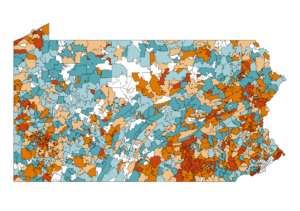 LAMPa’s coalition partners, the Housing Alliance of Pennsylvania, released an interactive web report on the rise of eviction filings in Pennsylvania post-pandemic. As people of faith, we grieve the ways in which so many of our neighbors are turned out of their homes and are called to work for policies that will promote a “sufficient, sustainable livelihood for all.”
LAMPa’s coalition partners, the Housing Alliance of Pennsylvania, released an interactive web report on the rise of eviction filings in Pennsylvania post-pandemic. As people of faith, we grieve the ways in which so many of our neighbors are turned out of their homes and are called to work for policies that will promote a “sufficient, sustainable livelihood for all.”
From the Housing Alliance of Pennsylvania website:
This report is an evaluation of how eviction filings and filing rates have changed over time and the communities where changes are concentrated. It analyzes the eviction filing data captured by the Administrative Office of Pennsylvania Courts over a five-year span starting July 1, 2018, to June 30, 2023.
- Pennsylvania’s eviction filings and rates have returned to pre-pandemic levels after being cut in half during the pandemic due to robust tenant protections and financial assistance programs.
- 115,000 households over the course of the year or 310 renter households every day face an eviction filing.
- 87% of eviction filings are concentrated in 20 counties in Pennsylvania. 80% renter households in Pennsylvania live in these same counties.
- 16 of those 20 counties have filing rates above the statewide average.
- The zip codes with the highest concentrations of eviction filings are the same compared to the pre-pandemic time period.
- While judgments for the plaintiff (the landlord) remain the most common outcome of a court ruling, there has been a modest decrease. And cases withdrawn have seen a nearly equal increase when compared to pre-pandemic years.
- Over 90% of cases involve past due rent demonstrating that non-payment of rent continues to be a main driver for eviction filings and resulting evictions.
- The number of tenants involved in eviction cases are behind on rent by more than 3 months – an increase from 26% pre-pandemic to 31%.
- Two thirds of judgments for the plaintiff (the landlord) provide an opportunity for tenants to pay back rent (called “pay and stay”) up until the legal lockout to avoid eviction.
- More cases are continued now compared to pre-pandemic numbers, although not at the same rate at which cases were continued during the pandemic.
To urge your policymakers to take action on proven, bipartisan supported policies to alleviate the housing crisis in Pennsylvania, see our Action Alert on the PHARE Fund and Whole Home Repairs Act.





